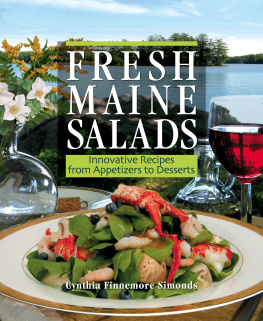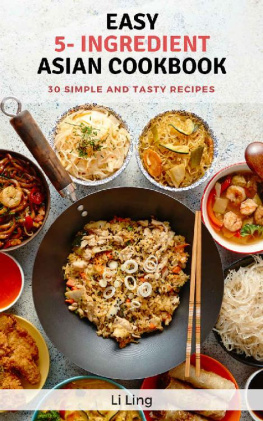

IN LOVING MEMORY OF MY MOM, WHO, LIKE MANY, LOVED TO NURTURE BUT HAD LITTLE TIME TO COOK. AND FOR ALL THE HOME COOKS WHO STRIVE TO GIVE THEIR LOVED ONES DELICIOUS, HEALTHY MEALS.


CONTENTS
INTRODUCTION
FOR A 19-YEAR-OLD college dropout who grew up in New England, traveling to Taiwan in the seventies to study food, language, and culture might have seemed like a radical thing to do. For me, it was my destiny, or so I thought when I purchased my hard-earned ticket. (I had juggled three different jobs, as an assistant baker, a pastry chef, and a sous chef, to earn the money for my passage.) It was only after boarding the plane and flying for 20 hours to the other side of the world that the reality of what I was doing actually sank in. What was I thinking?!
As it turned out, it was a fortuitous decision. I had been introduced to a Chinese surrogate family who had agreed to take me into their home. Miraculously, my Chinese mother, Mrs. Chang, turned out to be a famous cook who ran a cooking school where some of the Chinese mainlands best chefs from Taipeis finest restaurants taught their regional specialties.
By day, I was introduced to an enormous repertoire of classic banquet dishes from all over China, including crisp tea-smoked duck with ethereal steamed lotus buns, whole carp braised in a searing hot and sour sauce, and impressive hors doeuvre platters with slices of cooked meat and pickled vegetables shaped into ornate Dragon Meets Phoenix designs. I translated every recipe and meticulously recorded them in my journals. These recipes, along with the hundreds of Asian cookbooks I have collected during my numerous forays to Asia, inspired many of the dishes in the 10 cookbooks I have written through the years.
My Chinese godfather, T.C. Lai, calls these ornate dishes food for the eyes and not for the stomach. These days I couldnt agree more. The books and recipes lie neglected, gathering dust. Those elaborate restaurant dishes no longer fuel my ideas for cookingrather it is the home-style food that my Chinese family feasted on each night that inspires me.
The food was quite basic, but the flavors were fresh and appealing. Whereas previously I had always carefully eaten a small amount of food to maintain a svelte figure, I found that in China I could eat more and be satiated at the end of a meal. Combined with exercise, the pounds magically dropped away. I also realized it was a much healthier way to eat.
For family meals, Mrs. Chang and I purchased most of the ingredients on our pilgrimages to the local market several mornings a week. There might be a steamed fish doused with soy sauce or black vinegar and sprinkled with a touch of finely shredded ginger and scallions, or succulent, tender red-cooked spare-ribs or chicken simmered in an anise-flavored soy braising sauce. Vegetables were generally prepared simply, like a plate of stir-fried bean sprouts garnished with garlic chives, or seasonal vegetables flash-cooked with chopped garlic, salt, and rice wine. The menu changed to reflect the season and what was on hand in the kitchen. Many of the dishes were spontaneous creations.
I was particularly taken with the diverse selection of meal-in-one seafood or meat and vegetable casseroles and noodle platters that we prepared for Saturday or Sunday lunch or dinner. It is this wide-ranging assortment of simple, easy-to-prepare family dishes and meal-in-one platters that has inspired most of the recipes in this book. Ive adapted classic techniques and revised ingredients to take advantage of the growing selection of prepared foods and condiments now available in supermarkets. Ive also streamlined the recipes to fit my students busy lifestyles and my own. And after many years traveling to countries all over Asia, Ive broadened my repertoire to include dishes that reflect Pan-Asian influences.
In Asia, preparing the evening meal has always been a pleasurenot the chore that it has become for many multitasking working adults in this country. Indoor and outdoor market shelves are laden with mountains of vividly colored produce that evoke images of sensual watercolors, and the air is rich with the intoxicating fragrance of ripe ingredients that inspire dishes that feed family and friends.
Today, well-stocked supermarkets offer a wealth of products and ingredients that make home-cooking easier and help us make healthy and satisfying meals. Asian cooking fits seamlessly into this scenario. There are freshly cooked rotisserie chickens, an eclectic variety of quality prepared broths, precut and pre-washed vegetables, a growing variety of diverse whole grains, as well as an astounding array of spices and Asian sauces and condiments. All of this is in addition to booming farmers markets that offer gorgeous, freshly picked produce.
Youll notice that after many of the recipes, I have highlighted selected ingredients in the dish and listed their health-giving properties according to traditional Chinese medicine and scientific research. This reflects my keen interest in eating food thats healthy and delicious, a way of thinking that was ingrained in me from the beginning of my time in Asia. The Chinese have always embraced the idea of food as medicine, a topic I explored in depth in two of my previous books, A Spoonful of Ginger (Knopf, 1999) and Spices of Life (Knopf, 2005). It is a way of thinking and cooking that I still feel passionately about to this day. Chinese chefs and Asian cooks integrate this idea into all their food, whether it is simpler home-cooked dishes or more elaborate banquet fare.
Home cooking isnt fancy, but, as I discovered, its the food that nurtures. Many years later, after traveling to countries all over Asia and feasting on innumerable local delicacies, the banquet meals have become a blur while so many of the humbler dishes remain memorable. It is these foods that I have sought to adapt and recreate, and that have inspired most of the food in this book. It is my hope that the recipes will lure cooks into the kitchen by introducing them to more accessible, yet irresistible, Asian-inspired dishes and that they will dispel the myth that Asian cooking is too time-consuming and difficult to prepare on a daily basis.

THE NEW ASIAN PANTRY
WHEN I FIRST started writing about Chinese and Asian cooking in Gourmet magazine more than 30 years ago, the mainstream supermarket was a very different place. A trip to an Asian specialty market was a necessity in order to purchase the basic Asian condiments and produce to make most of the recipes.
Fortunately this is no longer the case: international aisles in todays supermarkets offer a great selection of basic Chinese, Thai, Japanese, Vietnamese, and Indian sauces and spices. Produce aisles are chock full of fat knobs of fresh ginger, stalks of lemongrass, and selected Asian vegetables, and freshly made wontons and noodlesnot to mention the amazing array of tofu productsare easy to find.
So the good news is that while it is helpful to have a pantry stocked with a few prime Asian ingredients, if you need to run out to purchase any, you wont have to drive far. Below is a list of staple items to have on hand when preparing many of the recipes in this book.
Next page










